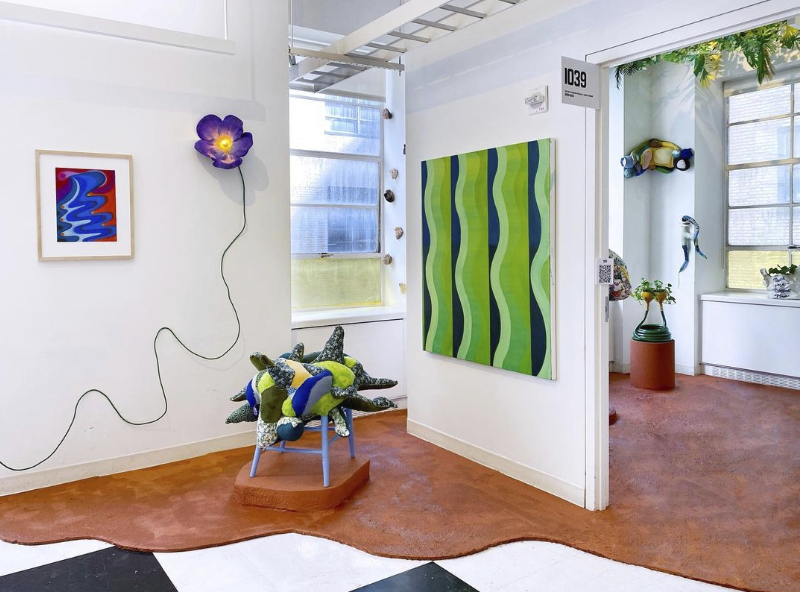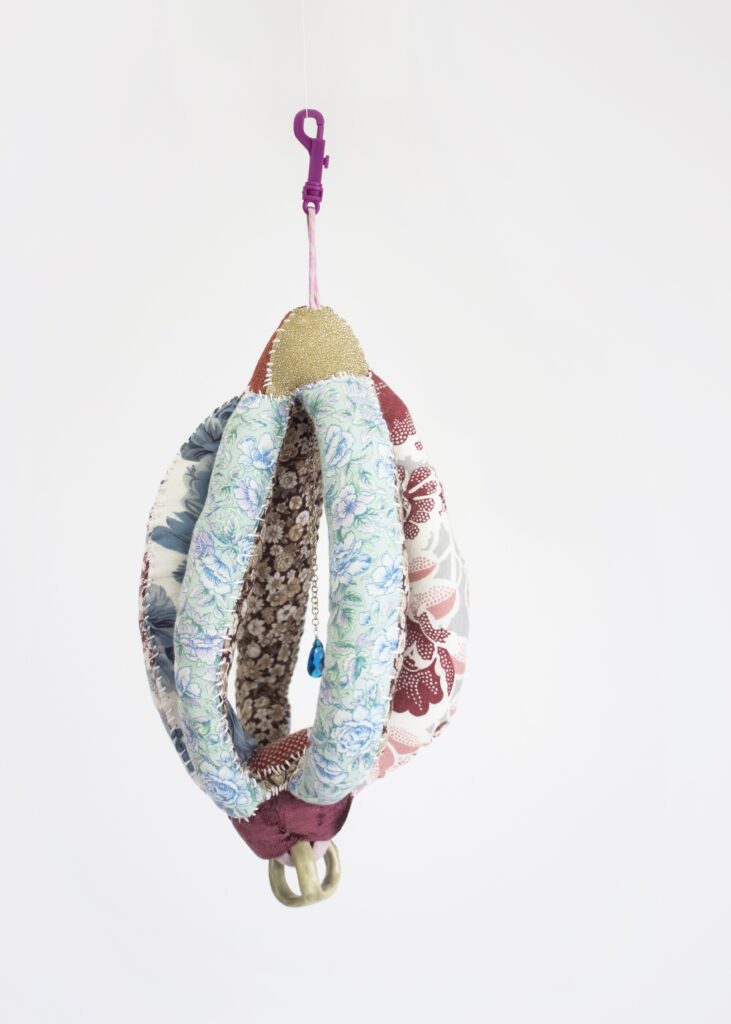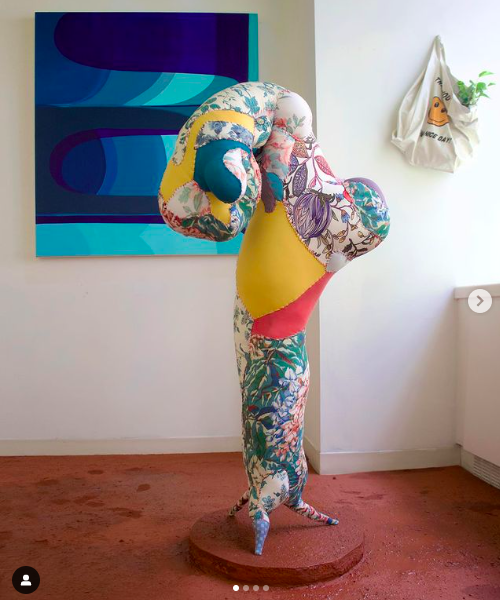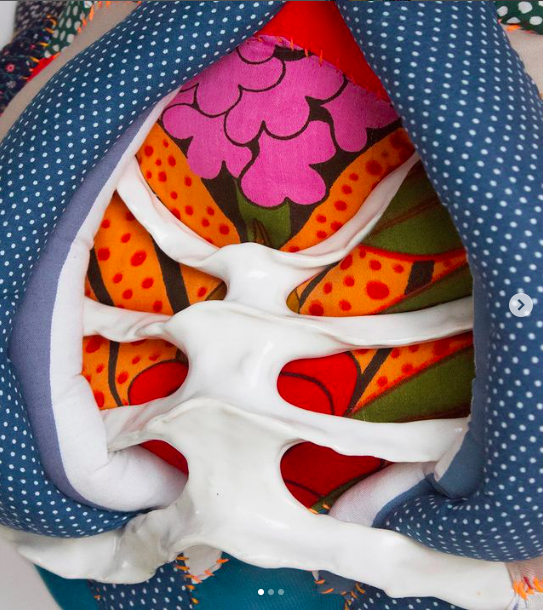Hanna Washburn’s Upcycled Cloth Sculptures Celebrate Memories


Upcycling clothes and materials has become a popular trend in the fashion industry. While traditionally defined as taking old, worn-out clothing with the purpose of turning those items into something entirely new (normally with the intention of forgetting what the clothing looked like in it’s older state), artist Hanna Washburn’s work is rooted in upcycling. Here’s how: Washburn utilizes old clothing, fabrics and other discarded materials that have history, turning these scraps into soft, cloth sculptures.
Washburn’s intention is not to totally transform these discarded items into something fresh and new, but to celebrate the nostalgia and memories that are contained within those layers of fabric. She often uses items from her childhood, her friends and family. Her sculptures have an anthropomorphic, creature-type of quality to them in the sense they feel like living and breathing objects. Curiously enough, a lot of her sculptures are named after parts of the body (leggy, marrow, and clavicle).
After seeing her work for the first time last year at SPRING/BREAK, I had the pleasure of visiting Hanna’s studio in Beacon, NY which sparked my interest in learning more about her artistic process, understanding her attachment to the items that she uses in her sculptures as well as the role of that nostalgia in her work.
“A lot of my work speaks to nostalgia, childhood, and the patchwork of building your identity. I am often trying to visually recreate those memories and feelings, so it is powerful to use the literal clothing or material from my childhood, or something that belonged to my mother or grandmother. It is an amazing artifact, a kind of fossil.“

Alexandra Israel: Last year at SPRING/BREAK art fair, I saw Green House and was immediately attracted to the bright colors as well as how the booth incorporated plant imagery. A booth curated by you and Marianna Peragallo, Green House called into question how we care for our environment and each other. I was immediately intrigued and knew I wanted to do a studio visit the next time I was up in Beacon, NY! Your work reminds me so much of the Haas Brothers, in the sense that your sculptures have a creature-like vibe with their own backstory. For those who aren’t familiar with your work, can you share more about yourself and your practice?
Hanna Washburn: I create sculptures using repurposed textiles, also incorporating furniture, household items, and ceramics. I am drawn to materials with former usages and connotations—I am always collecting and scavenging. I sew by hand and work intuitively, allowing the materials to guide me as I construct compound forms. The sculptures are about the body, the home, material memory, and femininity—and the way these things clash, intersect, and overlap.

Your work incorporates upcycled materials that have lived a lot of different lives. I read in an interview that you sometimes use actual objects from my childhood, or old and broken furniture from your parents’ attic. How do you know when an object speaks to you and it’s something you want to work with? Are there particular materials (shirts, socks, tablecloths, curtains etc) that you prefer working with?
That is a great question! It kind of depends—sometimes the connection is more obvious, like a form or pattern reminds me of something and I can see it taking shape in a sculpture. Other times the connection is harder to explain, like an object feels charged, or the texture of a fabric sparks something. A lot of my work speaks to nostalgia, childhood, and the patchwork of building your identity. I am often trying to visually recreate those memories and feelings, so it is powerful to use the literal clothing or material from my childhood, or something that belonged to my mother or grandmother. It is an amazing artifact, a kind of fossil.
Textiles and objects that speak to domesticity are particularly interesting to me. Anytime someone in my family is clearing out their home, I am there, picking up all the discards and taking them to my studio. My work sometimes becomes about the absence of a thing—a piece of clothing I no longer have or an object I only remember in photographs. When you no longer have the artifact, how do you re-create it? How do you capture its essence?

When I visited your studio, we talked about how your work hints at also being functional. For example, Swell is shaped in the form of a chaise and looks like something that could be incorporated in your living room and work both as an art piece and something to lounge on. Was that intentional?
I think about functionality all the time, how we define it and attribute it to things in our lives. I am especially interested in furniture as something that we rest our bodies on, asking it to hold our weight—a comfort we so often take for granted. These forms are always supporting us. My practice explores what it would be like if “inanimate” things took on bodies and personalities—if they became themselves and were not only defined by their function. How does that change how we relate to them? Swell really speaks to that, especially the contrast of the bulging, swelling form on spindly legs.

You were recently part of a group exhibition, Homespun at the Dorsky Museum of Art, which ended recently. Curated by Karlyn Benson, Homespun explores the works of nineteen artists (all based in the Hudson Valley) and the different approaches to textile art. It seems there is a personal and emotional component to using recycled material (that at one point belonged to someone and has history). Can you talk a little bit more about that?
Homespun is such an amazing exhibition, and I am so happy to be a part of it. Textiles are something that I’ve always felt connected to—I think because I learned these practices from women in my family, not in art school. It is an inherited interest and skill, often done in the home surrounded by family. Having the opportunity to learn more about the other artists in the show, it is clear this is something many of us share: our connection to fiber runs deep, and is very personal. Many artists in the exhibition repurpose textiles from their own lives, which is such an intimate exercise. Textiles are so much about community and material memory, and it has been wonderful to get to know all these artists working in such varied ways. Many thanks to Karlyn Benson and the Dorsky Museum for putting the exhibition together!

Installation view of Buddy System at Smallbany Gallery. Photo courtesy of the artist.
Do you have a vision of what your sculptures will look like before you get to work? Or does it depend on the materials?
It depends! I usually start with a broad idea of where I’d like to go, but I often find myself taking unexpected twists and turns. I like it that way—I like to be really engaged in the process physically and mentally as I am working, giving myself room to make intuitive creative and compositional choices. There is this push and pull in my work—it is very time intensive because I sew everything by hand. At the same time there is this fluidity to the process; I think that is one of the reasons I am drawn to hand sewing, that it can be so additive and direct.

This question was inspired by a different interview that you did, but it’s too good not to ask! In an ideal world, how would your sculptures be shown (either in a museum or a private home)? How would you like people to engage with your work? There is a very touchable and textured quality to your sculptures.
I think both! My work changes so much depending on the context. There is something so compelling to me about taking the materials of the home, taking them into my studio, and then bringing them back into a home having gone through this transformation. I kind of love that idea. But I am also so grateful for opportunities to share my work with wider audiences, and contextualize it with other artists and their practices. Sometimes I think about certain sculptures I’ve made, and all the different places they’ve been: starting from the history of their materials, to their construction in my studio, and the various exhibition venues or private homes. That journey becomes part of the work.

What else is coming down the pipeline?
Time in the studio! I always have so many ideas kicking around my brain that I want to try.
I am really looking forward to an upcoming artist residency at the Haystack Mountain School of Crafts this summer, and a solo exhibition at the Lake George Arts Project in the fall.
To learn more about Hanna Washburn, please check out her website or her Instagram.
You Might Also Like
Wigs, Wigs, and More Wigs: Cj Hendry’s Blonde Pop-Up Takes Over Brookfield Plaza
What's Your Reaction?
Alexandra Israel graduated from Bates College in 2010. A museum aficionado since her introduction to Jean Dominque Ingres' portraits as a small child, she enjoys spending her free time at museums and finding off-the-beaten-track gallery shows. Israel has been working in PR for over seven years, primarily within book publishing and in the art world. She has held positions at Penguin Book Group, Aperture Foundation, and Third Eye among others. l Instagram l

